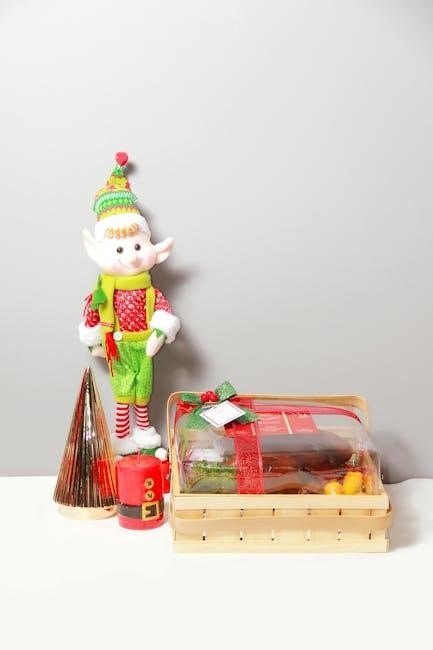rolling gate guide rollers
Rolling gate guide rollers are essential components that stabilize and guide sliding gates, ensuring smooth operation. They reduce friction and prevent gates from derailing, enhancing safety and durability. Available in various materials like nylon, steel, and rubber, these rollers are crucial for both residential and commercial gate systems, providing reliable performance and ease of use.
1.1 Definition and Purpose
Rolling gate guide rollers are mechanical components designed to stabilize and guide sliding gates, ensuring smooth and consistent movement. They are typically installed on gate posts and feature wheels or rollers that glide along the gate’s track. Their primary purpose is to reduce friction, prevent misalignment, and enhance overall gate stability, ensuring safe and efficient operation for both residential and commercial applications.
1.2 Importance in Sliding Gate Systems
Rolling gate guide rollers play a crucial role in ensuring the smooth and stable operation of sliding gate systems. They prevent gates from falling off tracks, reduce friction, and enhance overall stability. By guiding the gate’s movement, they minimize wear and tear, ensuring prolonged system longevity. Their importance lies in maintaining safety, efficiency, and reliability, making them indispensable for both residential and commercial gate installations.

Types of Rolling Gate Guide Rollers
Rolling gate guide rollers are categorized into standard, adjustable, and heavy-duty types, each designed to meet specific gate requirements, ensuring smooth operation and durability in various settings.
2.1 Standard Guide Rollers
Standard guide rollers are the most common type, designed for general use in sliding gate systems. Typically made of durable nylon, they offer smooth operation and minimal maintenance. These rollers are ideal for gates on level ground, providing consistent performance and stability. Their fixed offset design ensures reliable tracking, preventing the gate from swaying or derailing. Easy to install and suitable for residential and light commercial applications, they are a cost-effective solution for standard gate setups.
2.2 Adjustable Guide Rollers
Adjustable guide rollers offer flexibility in installation and operation, catering to gates on uneven ground or with slight curves. Their horizontal and vertical alignment options allow for precise setup, ensuring smooth movement and stability. Made from durable materials like nylon or steel, they are ideal for gates requiring customization. Popular for their adaptability, adjustable rollers enhance performance in various environments, making them a versatile choice for both residential and commercial applications.
2.3 Heavy-Duty Guide Rollers
Heavy-duty guide rollers are designed for robust applications, featuring ultra-high molecular weight nylon or steel construction. They offer superior load capacity and durability, ideal for large or weighted gates. These rollers minimize wear and tear, ensuring smooth operation even under heavy use. Their reinforced brackets and corrosion-resistant finishes make them suitable for harsh environments, providing long-lasting stability and reliability for industrial and high-traffic gate systems.
Materials and Durability
Rolling gate guide rollers are made from durable materials like nylon, steel, and rubber, ensuring longevity and smooth operation. Nylon rollers are corrosion-resistant and low-maintenance, while steel rollers offer superior strength for heavy-duty applications. Rubber rollers provide cushioning and stability, making them ideal for various gate systems and environments.
3.1 Nylon Rollers
Nylon rollers are lightweight, corrosion-resistant, and offer minimal maintenance. They provide smooth, quiet operation and are ideal for residential and commercial gates. Durable and wear-resistant, nylon rollers are suitable for various environments, ensuring consistent performance and longevity. Their versatility makes them a popular choice for sliding gate systems, delivering reliable functionality and ease of use over time.
3.2 Steel Rollers
Steel rollers are heavy-duty options designed for larger, heavier gates. Made from durable materials like galvanized steel, they offer exceptional strength and stability. Their robust construction ensures long-lasting performance, making them ideal for high-traffic or industrial settings. Steel rollers provide superior load capacity and are often used in harsh environments, delivering reliable operation and minimal wear over time. They are a preferred choice for gates requiring maximum durability and support.
3.3 Rubber Rollers
Rubber rollers are ideal for providing a cushioning effect and reducing noise during gate operation. They are typically attached vertically to posts to stabilize the gate and prevent tipping. Made from durable rubber, these rollers offer excellent grip and are suitable for various environmental conditions. Their soft yet resilient material ensures smooth movement and shock absorption, making them a quiet and reliable choice for sliding gate systems. Rubber rollers are also low-maintenance and easy to install.
Installation and Adjustment
Rolling gate guide rollers are designed for easy installation and adjustment, with pre-assembled components and options for horizontal and vertical alignment to ensure smooth gate operation.
4.1 Step-by-Step Installation Guide
Install guide rollers by first preparing the gate and posts. Attach the L-shaped brackets to the gate posts using bolts. Align the rollers with the track, ensuring proper spacing. Secure the rollers to the brackets and adjust their position for smooth operation. Tighten all bolts firmly and test the gate’s movement to ensure stability and alignment. Follow manufacturer instructions for specific models to guarantee correct installation.
4.2 Horizontal and Vertical Adjustment Options
Rolling gate guide rollers often feature adjustable mechanisms, allowing for fine-tuning of their position. Horizontal adjustments ensure proper alignment with the track, while vertical adjustments maintain the correct height. These options enable precise calibration to accommodate uneven surfaces or gate sagging. Easy-to-use bolts or screws typically facilitate adjustments, ensuring smooth gate operation and preventing derailments. Regular adjustments can extend the lifespan of both the rollers and the gate system.

Maintenance and Repair
Regular cleaning and lubrication of rollers ensure smooth operation. Replacing worn-out rollers is crucial for maintaining gate stability. Durable materials like nylon and steel reduce maintenance needs.
5.1 Cleaning and Lubrication
Regular cleaning of guide rollers removes dirt and debris, ensuring smooth operation. Lubrication with silicone-based sprays reduces friction and prevents wear. Nylon rollers benefit from this maintenance, enhancing durability and performance. Proper care extends the lifespan of rollers, maintaining gate stability and functionality. This routine upkeep is essential for both residential and commercial sliding gate systems.

5.2 Replacing Worn-Out Rollers
Replacing worn-out guide rollers is crucial for maintaining gate stability and smooth operation. Damaged rollers can cause misalignment and instability. Use high-quality replacements, such as nylon or steel, to ensure durability. Installation typically involves removing the old roller and securing the new one with bolts or welding. Proper replacement prevents further damage and ensures the gate functions safely and efficiently, avoiding potential safety hazards.

Security and Safety Features
Rolling gate guide rollers enhance security by preventing tipping and ensuring stable gate movement. Anti-tipping mechanisms and robust load capacities maintain structural integrity, ensuring safe operation and preventing accidents.
6.1 Anti-Tipping Mechanisms
Anti-tipping mechanisms in rolling gate guide rollers prevent gates from tilting or falling off their tracks. Rubber rollers are often vertically attached to posts to stabilize gates, while overhead guide wheels with ball bearings ensure smooth, tip-resistant operation. These mechanisms are crucial for maintaining gate alignment and preventing accidents, especially on uneven ground or with curved gate designs.
6.2 Load Capacity and Stability
Rolling gate guide rollers are designed to handle varying loads, ensuring stability and smooth operation. Heavy-duty models, made from ultra-high molecular weight nylon or steel, offer superior load-bearing capacity. Proper alignment and installation enhance stability, while features like ball bearings reduce friction and wear. Choosing rollers suited to the gate’s weight and usage ensures reliable performance and longevity, preventing uneven wear and maintaining consistent functionality over time.
Common Issues and Solutions
Common issues with rolling gate guide rollers include friction, misalignment, and wear. Solutions involve regular lubrication, proper alignment, and timely replacement of worn components.
7.1 Friction and Smooth Operation
Friction can hinder the smooth operation of rolling gate guide rollers, causing uneven movement. Regular lubrication of rollers and tracks is essential to reduce friction. Nylon rollers are ideal for quiet operation, while steel rollers may require more maintenance. Proper alignment and cleaning of debris also ensure smooth functionality. Addressing friction issues promptly prevents wear and extends the lifespan of the gate system.
7.2 Alignment and Tracking Problems
Misalignment and tracking issues can disrupt the smooth operation of rolling gates. Uneven ground or improper installation often causes gates to veer off course. Adjustable guide rollers help correct alignment, while heavy-duty rollers provide stability. Regular inspection and tightening of bolts ensure proper tracking. Correcting these issues promptly prevents further damage and ensures the gate operates efficiently and safely over time.

Choosing the Right Guide Rollers

Selecting the right guide rollers involves considering gate weight, material, and usage. Nylon rollers offer durability, while steel rollers provide strength. Adjustable options ensure versatility, and rubber rollers enhance stability. Choose rollers compatible with your gate system for optimal performance and longevity, ensuring smooth operation and reliability in various conditions.
8.1 Factors to Consider
When selecting guide rollers, consider gate weight, material durability, and intended use. Nylon rollers are ideal for lightweight gates, while steel rollers suit heavy-duty applications. Assess the gate’s movement patterns and track conditions. Adjustable rollers offer flexibility for uneven surfaces, and rubber rollers provide stability. Ensure compatibility with your gate’s size and type, and evaluate maintenance needs to ensure long-term performance and reliability.
8.2 Brands and Quality Standards
Reputable brands like Allomatic and Windowo offer high-quality guide rollers, ensuring durability and performance. Look for rollers made from ultra-durable materials such as UHMW plastic or heavy-duty steel. Ensure the product meets industry standards for load capacity and corrosion resistance. Brands with certifications and positive reviews often provide superior reliability. Prioritize brands that offer warranties and adhere to strict manufacturing processes for optimal gate functionality and longevity.




























































